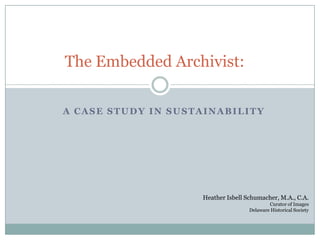
The Embedded Archivist: A Case Study in Sustainability
- 1. The Embedded Archivist: A CASE STUDY IN SUSTAINABILITY Heather Isbell Schumacher, M.A., C.A. Curator of Images Delaware Historical Society
- 2. A gig economy 31.7% of recent graduates from archives programs are employed in temporary positions or ones based on a grant or project Shannon Lausch and Rebecca Goldman, survey, June 2012 In 2009, 29% of job announcements were for temporary positions (1-3 years). Of these temporary positions, half were 2 year projects, nearly half were 1 year or less, and only 5 were 3 years Dana Miller, SAA presentation on survey of job announcements, 2009
- 3. A gig economy This raises some questions: What impact do these short-term projects have on the long-term sustainability of archival institutions? How will knowledge be transferred from project staff to permanent staff and future archivists?
- 4. Case Study: Delaware Historical Society Online Cataloging Project 2-year grant from IMLS Project team Project Manager: oversee project; also responsible for cataloging published materials Project Catalogers: catalog manuscript and photograph collections Goals 65% of library’s collections on OPAC, AskCaesar institute cataloging standards install reading room computers for catalog reference
- 5. About the Delaware Historical Society Includes museum, research library, and 2 historic properties 12 full-time, permanent staff members Library staff—all there 15+ years Director of Library/Curator of Manuscripts Curator of Images Curator of Printed Media Loss of full-time exhibits manager in fall 2009 put pressure on library staff to research and design all exhibits—less time to devote to cataloging
- 6. Issue: • DHS Photograph Collection Retrieval Inconsistent titles and no definitive order within the series Moving collections to the OPAC • Vault collections revealed Boxes not well labeled inefficiencies with Had been grouped thematically, but difficult existing retrieval to maintain this scheme over time system.
- 7. Solutions DHS Photograph Vault collections Collection Devised three-letter call Created box numbering number system system—collections assigned an arbitrary box Consulted with the number that’s clearly Curator of Images noted on the OPAC Received approval and input from Curator of Manuscripts
- 8. DHS vault
- 9. Issue: Created cataloging manual to Cataloging standardize practices. standards Communicated throughout and documented standards once agreed Each curator upon—at end of project, compiled notes created practices into a manual for their own collections, resulting in three Can easily train interns and new staff different on cataloging software, and provide for procedures. consistency in the future
- 10. Issue: Created top-level only records for Maximizing remaining collections. public access Give the public a better idea of our overall holdings Had to consider post-project needs in devising strategy Considered time constraints of the for last six months library staff going forward of grant. Result: about 70% of these manuscript collections will be available online at the conclusion of the project
- 11. Issue: Held staff training on how to use the OPAC. Training staff Makes better use of librarians’ time DHS staff As a small staff, it’s vital that we are all members in other able to speak to the public with some departments were knowledge about all of our initiatives unfamiliar with how to use the OPAC.
- 12. Conclusions Stay in touch with your project team. Address issues as they arise—our cataloging team met regularly and used Yammer for quick conversations and sharing information. Listen to the needs of the permanent staff. Sustainability hinges upon their buy-in and acceptance of any changes made during the course of the project. Document, document, document. Record all of your efforts through monthly reports, meeting minutes, etc.